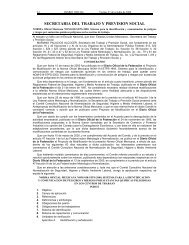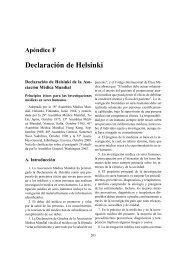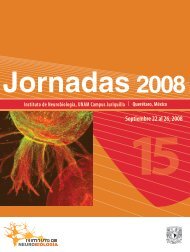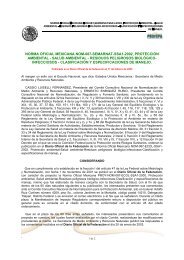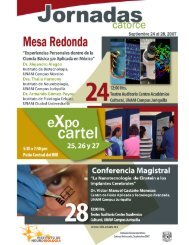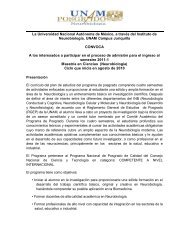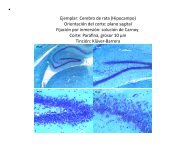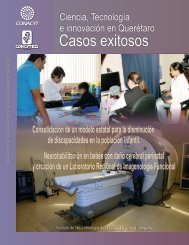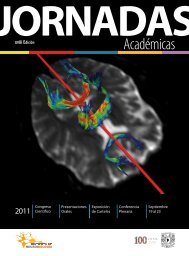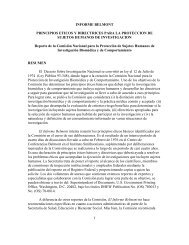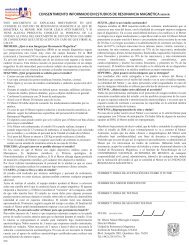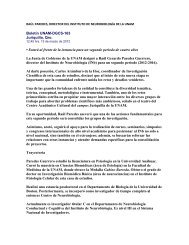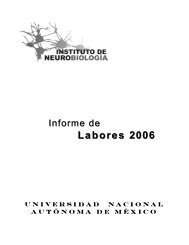Hormonas Tiroideas y Cerebro. Notas Sobre La Relación Bocio y ...
Hormonas Tiroideas y Cerebro. Notas Sobre La Relación Bocio y ...
Hormonas Tiroideas y Cerebro. Notas Sobre La Relación Bocio y ...
You also want an ePaper? Increase the reach of your titles
YUMPU automatically turns print PDFs into web optimized ePapers that Google loves.
Figure 3. The thyrotroph: an example of T3<br />
homeostasis. T 3 can arrive in the nucleus from 2 distinct<br />
sources: plasma T 3 , illustrated as T 3 [T 3 ]; and plasma T 4 ,<br />
which is then converted to T 3 intracellularly via the D2<br />
pathway, represented as T 3 [T 4 ]. D2-mediated T 4 -to-T 3<br />
conversion occurs at variable rates, decreasing as serum T 4<br />
concentration increases. Ultimately, these processes<br />
determine nuclear TR saturation, which includes<br />
contributions from both T 3 (T 3 ) and T 3 (T 4 ) as indicated, with<br />
only a minor fraction of the TRs being unoccupied under<br />
normal conditions. Taken from (7).<br />
Abnormalities in deiodinase activity are important in a number of clinical settings. The bestknown<br />
example is critical illness, during which changes in deiodinase activities are linked to complex<br />
alterations in TH metabolism. Another common setting is patients being treated with amiodarone, an<br />
antiarrhythmic drug well known to alter thyroid function tests via both direct actions on the thyroid and<br />
inhibition of T 4 activation. While rare, vascular tumors with high D3 activity have been shown to cause<br />
severe hypothyroidism in both adults and children. Increased D3 activity as a general mechanism may<br />
have much broader clinical relevance; as fetoplacental and uterine D3 activity increase dramatically<br />
during pregnancy. This activity may be the cause of increased L-thyroxine requirements in pregnant<br />
patients with hypothyroidism. Individuals with genetic alterations in the deiodinases have not yet been<br />
identified, though the clinical implications of several polymorphisms are under investigation.<br />
Understanding the signaling pathways these enzymes are involved with could have therapeutic utility<br />
for all of these clinical settings (reviewed by 4, 7).<br />
Deiodinases in thyroid homeostasis<br />
Serum T 3 levels are relatively constant in healthy subjects; a finding that is not surprising<br />
considering that T 3 is such a pleiotropic molecule. The deiodinase signaling pathways in peripheral<br />
tissues constitute a major determinant of plasma T 3 level, since all T 3 generated in the cytoplasm<br />
eventually exits the cell, unless of course it is intracellularly metabolized. In fact, extrathyroidal<br />
pathways have been estimated to contribute about 80% of T 3 produced daily in healthy subjects (8).<br />
The D2 pathway is thought to be the major source of extrathyroidal T 3 production in humans based on<br />
a number of clinical studies (reviewed by 7). In contrast, D1 activity is increased in patients with<br />
hyperthyroidism so that this pathway becomes the predominant extrathyroidal source of T 3 in this<br />
pathology (9). This D1 predominance underlies the rapid fall in serum T 3 concentrations that occurs in<br />
hyperthyroid patients treated with propylthiouracil (PTU), an antithyroid drug that selectively inhibits<br />
D1-mediated T 3 production. The D3 pathway is recognized as being the predominant means for<br />
clearance of plasma T 3 . A dramatic example of the potency of the D3 pathway in determining serum T 3<br />
concentrations is shown in the syndrome of consumptive hypothyroidism, in which T 4 and T 3 clearance<br />
rates are greatly accelerated because of the presence of large infantile hepatic hemangiomas with<br />
high levels of D3 activity (Table 1) (reviewed by 7).<br />
The activity of deiodinases is tightly integrated and thus promotes the maintenance of both,<br />
serum and intracellular T 3 concentrations. Fluctuations in serum T 4 and T 3 concentrations lead to<br />
homeostatic, reciprocal changes in the activity of D2 and D3 (3-5). As serum T 3 concentrations<br />
increase, expression of Dio3, which encodes D3, is upregulated, increasing T 3 clearance, while<br />
expression of Dio2, which encodes D2, is modestly downregulated, decreasing T 3 production.<br />
Conversely, if serum T 3 concentrations were to fall, downregulation of the D3 pathway would decrease<br />
the clearance of T 3 . The homeostatic role of D1 is less intuitive, as Dio1 is T 3 responsive (9). Given<br />
that D1 can deiodinate the phenolic and tyrosil rings of T 4 with equal facility, D1 in effect activates only<br />
18



